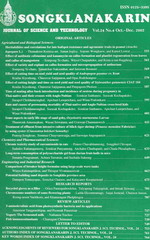ThaiScience
ThaiScience
SONGKLANAKARIN JOURNAL OF SCIENCE & TECHNOLOGY
Volume 41, No. 05, Month SEPTEMBER, Year 2019, Pages 1124 - 1130
Using markov chains to forecast the proportion of noncommunicable diseases
Vadhana Jayathavaj and Pranee Boonya
Abstract Download PDF
The university personnel annual medical check-up reports of the years 2015-2017 are classified by the 16 categories of noncommunicable diseases (NCDs) from the combinations of the 4 criteria: high fasting blood sugar, high blood pressure, high triglycerides or high cholesterol or high low-density lipoprotein, and the abnormal signs from an electrocardiogram. This study aims to project the future proportion of NCDS in order to reflect the past and current university health policy. The Markov chains are the categorical time series prediction model that are applied to identify the probabilities of short-run and long-run events for each NCD states (category). The estimated state probability of the year 2017 that is derived from the transition matrix of the year 2015 to 2016 is close to the real state probability of the year 2017 using the Chi-squared goodness of fit test (p-value < 0.002, degrees of freedom 15). The prediction for the steps of short-run (2018-2019) and long-run (2022 and so on) show that the NCDs with many more combinations will increase about 1% each, while the NCDs with lesser combinations will decrease by 1% each.
Keywords
Markov chain, noncommunicable diseases, proportion, state, stepSONGKLANAKARIN JOURNAL OF SCIENCE & TECHNOLOGY
Published by : Prince of Songkla University
Contributions welcome at : http://rdo.psu.ac.th
